

Winter 2023 A Publication of MONMOUTH MEDICAL CENTER BREATHING EASIER WITH COPD BEATING KNEE PAIN HAVING YOUR BABY, YOUR WAY healthytogether BETTER WOMEN’S HEALTH AT EVERY AGE
“As we enter into 2023 with a renewed sense of purpose, accomplishment and optimism, it’s a great time to focus on getting and staying healthy by making preventive care a priority. And we’re making it easier for you to do all of these things at RWJBarnabas Health. We’ve welcomed even more nationally recognized clinicians; expanded telehealth; built ambulatory and satellite facilities so that our patients can receive healthcare closer to home; and we continue to improve, expand and modernize our facilities with state-of-the-art equipment and technology. We wish you the best of health in the New Year.”
MARK E. MANIGAN PRESIDENT AND CHIEF EXECUTIVE OFFICER, RWJBARNABAS HEALTH

“At Monmouth Medical Center, we are committed to creating healthier communities by helping ensure our community members have the knowledge and ability to live healthier, more fulfilling lives and achieve disease prevention through innovative community education programs. And it is a commitment we have for our hospital heroes as well: In this issue you can read about a tranquil new space that a generous local family gifted to our staff to help them take some time to breathe, relax, reflect, receive a chair massage, meditate and practice critical self-care.”
ERIC CARNEY PRESIDENT AND CHIEF EXECUTIVE OFFICER, MONMOUTH MEDICAL CENTER AND MONMOUTH MEDICAL CENTER SOUTHERN CAMPUS
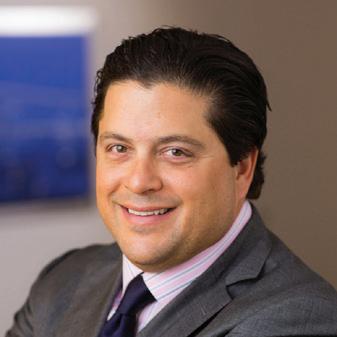
RECEIVING THE HIGHEST PATIENT SAFETY SCORE
Monmouth Medical Center (MMC) received an “A” Hospital Safety Grade rating by The Leapfrog Group, an independent national nonprofit run by employers and other large purchasers of health benefits, in results announced in November. MMC is the only hospital in the region to receive Leapfrog’s “A” Hospital Safety Grade for 16 consecutive rating periods.
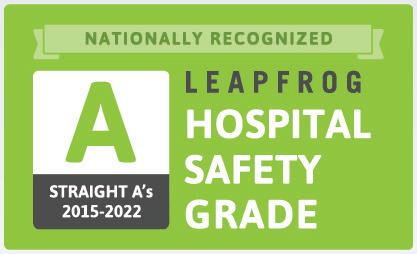
The Leapfrog Hospital Safety Grade is the only hospital ratings program based exclusively on prevention of medical errors and harm to patients. “Our 16 consecutive ‘A’ grades demonstrate the commitment and intentional focus on safety and quality by all of our caregivers and recognize the high-quality care we deliver to our patients and their families every day,” said Eric Carney, the hospital’s President and Chief Executive Officer. He notes that the latest “A” grade comes on the heels of the announcement by the digital platform Money that MMC was among just 148 U.S. hospitals named to its inaugural list of the Best Hospitals in America.
300 Second Avenue, Long Branch, NJ 07740 | 732.222.5200
CONNECT WITH US ON
Monmouth Medical Center complies with applicable federal civil rights laws and does not discriminate on the basis of race, color, national origin, age, disability, or sex. For more information, see link on our home page at www.rwjbh.org/monmouth. Monmouth Medical Center cumple con las leyes federales de derechos civiles aplicables y no discrimina por motivos de raza, color, nacionalidad, edad, discapacidad o sexo. ATENCIÓN: Si usted habla español, servicios de asistencia lingüística, de forma gratuita, están disponibles para usted. Llame al 732.222.5200. Monmouth Medical Center konfòm ak lwa sou dwa sivil federal ki aplikab yo e li pa fè diskriminasyon sou baz ras, koulè, peyi orijin, laj, enfimite oswa sèks. ATANSYON: Si w pale Kreyòl Ayisyen, gen sèvis èd pou lang ki disponib gratis pou ou. Rele 732.222.5200.
For issues regarding delivery of Healthy Together, please write to HTcirculation@wainscotmedia.com.
HONORED FOR EXCELLENCE IN DIGITAL HEALTH TECHNOLOGY
The College of Healthcare Information Management Executives (CHIME) released its coveted Digital Health Most Wired survey results for 2022, recognizing MMC with Most Wired status.
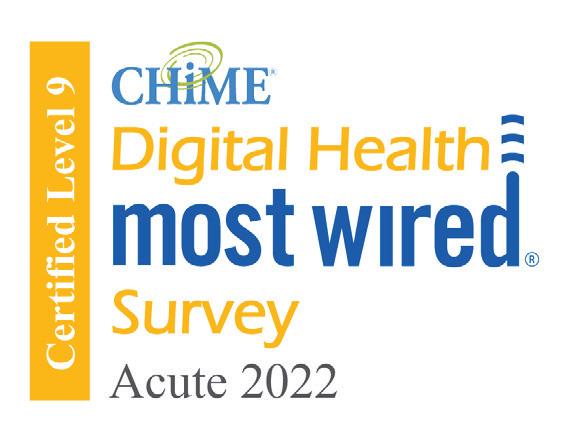
Among more than 38,000 organizations surveyed by CHIME, RWJBarnabas Health ranked above peers in categories such as analytics and data management, population health, infrastructure and patient engagement. The survey assessed the adoption, integration and impact of technologies in healthcare organizations at all stages from early development to industry leading.
MMC achieved Performance Excellence Level 9 in the Acute category, the second-highest level possible. Success in digital health increasingly determines patient-care quality, and the scope of the CHIME survey reflects the progress of leading healthcare providers as they reinvent healthcare for a new century.
HEALTH NEWS
@MonmouthMedicalCenter @RWJBarnabas
RWJBarnabas Health
MESSAGES FROM LEADERSHIP
@MonmouthMedical
Healthy Together | 2 | Winter 2023
‘I NEVER FELT I WASN’T HEARD.’ A team approach enhances childbirth.

‘I’M VERY EXCITED.’ A cancer care leader anticipates a hometown medical campus.

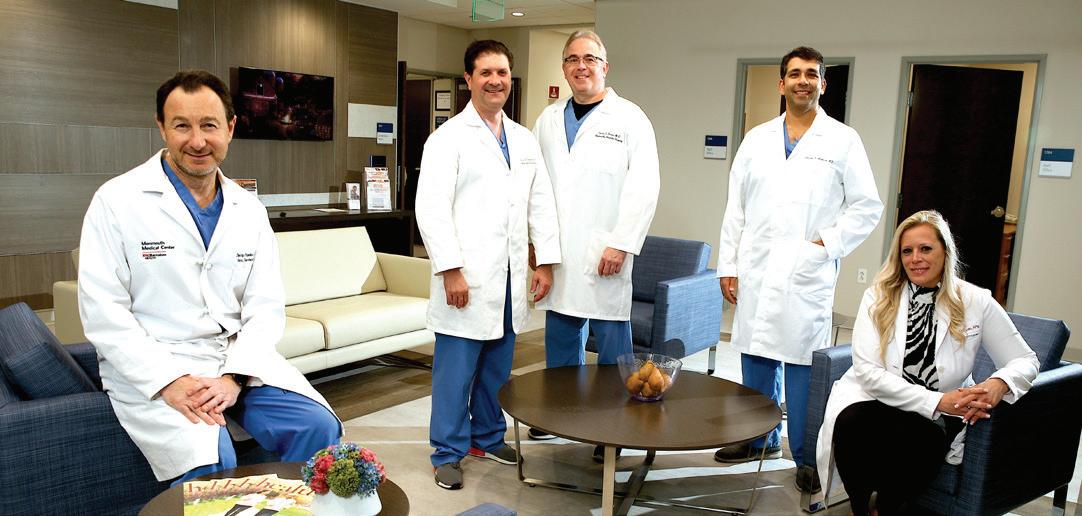
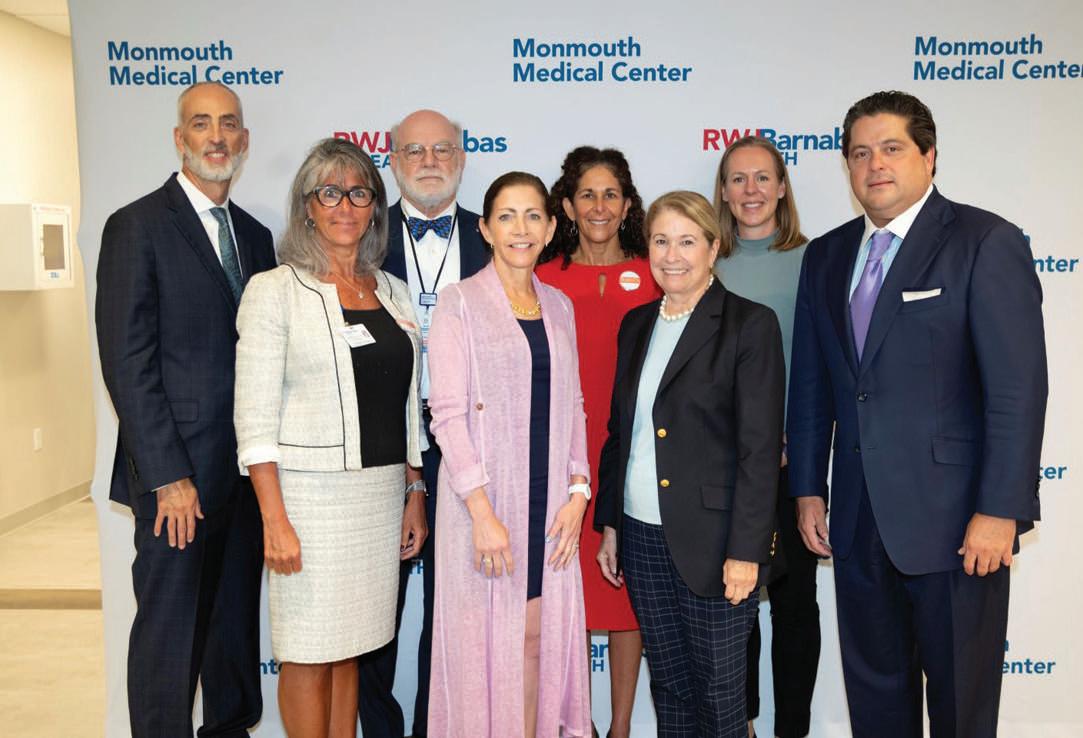
A BREAKTHROUGH AGAINST COPD. Breathing easier with a new valve therapy.

FAMILIES THAT GIVE TOGETHER. New spaces open thanks to generous donations.

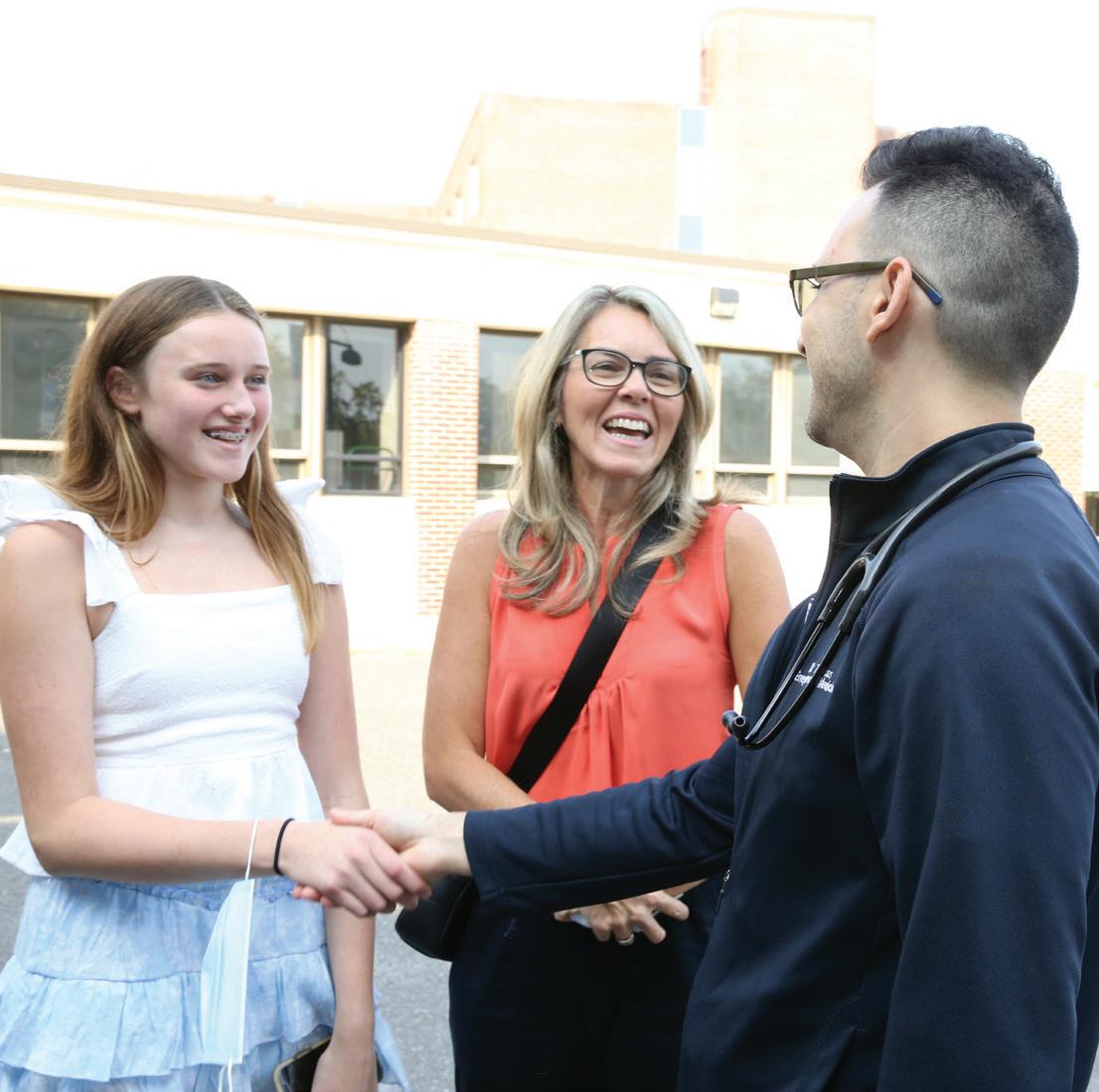
22 4 contents WINTER
18 20 7 2.
4.
6.
7.
8.
17.
18.
20.
22.
11.
12.
14.
15.
16.
12 9.
10.
Monmouth Medical Center | RWJBH.ORG/MONMOUTH 3
2023 healthytogether
WELCOME LETTER. A community update from our leadership.
ACTION THERAPY. Psychodrama addresses emotional issues.
BACK ON THEIR FEET. Knee replacements let two women live their best lives.
‘MOTILITY DISORDERS CAN BE SERIOUS.’ What to know about problems with the esophagus.
‘I’M VERY, VERY THANKFUL.’ More people now benefit from the cardiac procedure that saved this woman.
HEMATOLOGY DREAM TEAM. Meet the world-class team of doctors treating blood disorders and cancers.
BETTER WOMEN’S HEALTH AT EVERY AGE. From adolescents to seniors: what every woman needs to know.
SPECIALTY OUTPATIENT CARE FOR KIDS. Children’s Specialized Hospital offers a range of services at 14 locations.
BEYOND BED-WETTING. Treating urologic conditions in children.
BANKING ON LIFE. How, where and when to donate blood this winter.
PREVENTING SUICIDE. What you say and do may help save a life.
CARDIO VS. STRENGTH TRAINING. Which is better for heart health? Resolving an old debate.
‘I NEVER FELT I WASN’T HEARD’
SHARED DECISIONMAKING ENHANCES CHILDBIRTH IN A NEW INITIATIVE.

Healthy Together | 4 | Winter 2023
Kathryn and Matthew Norton welcome their son, Charlie, moments after birth.
Kathryn Norton entered Monmouth Medical Center (MMC) to have her first child July 24, 2022, and gave birth July 26. Labor lasted 45 hours—long enough that one of her nurses, Ashley Fava, RN, served two separate shifts on consecutive days. “We tried many different things, but this baby was not coming on his own,” Kathryn says.

Yet Kathryn is upbeat. “We had a fabulous experience,” she says. “I cannot say enough about the labor and delivery nurses who helped us. Ashley’s positivity and realism, and the way she advocated for me and my baby were beyond anything we expected.”
Advocating for patients and shared decision-making are among keys to a new initiative called TeamBirth NJ. MMC launched TeamBirth with two other New Jersey hospitals along with the New Jersey Health Care Quality Institute and Ariadne Labs, a joint center for health systems innovation at Brigham and Women’s Hospital and the Harvard T.H. Chan School of Public Health in Boston, in partnership with New Jersey’s Department of Health.
TeamBirth aims to enhance birthing experiences and improve outcomes. Core tenets include that the person giving birth and their support person are integral parts of the care team, and that all parties should have clear expectations from knowing the patient’s preferences, symptoms and experiences.
A TOUGH CALL
Kathryn’s induced delivery shortly before the initiative launched shows how the program naturally fits MMC.
Even with medications and therapies, Kathryn’s cervix hadn’t dilated enough. Nurses helped her do yoga and use a peanut-shaped ball, and even piped in favorite country music. “They offered anything they thought could help,” Kathryn says. “None of it was working.”
Doctors finally advised delivering by cesarean section. “That was not my plan, especially after working so long for a natural birth,” Kathryn says. Fava recommended the team keep trying for vaginal delivery, emphasizing that mother and baby remained healthy. Doctors agreed.
“That meant so much to me because it showed Ashley and the team knew how much I wanted a natural birth, understood my plan and wanted to help me achieve it,” Kathryn says.
After almost two more hours of labor, the team—including Kathryn and her husband, Matthew—decided to proceed with the C-section. “We had literally exhausted all our options,” Kathryn says.
Baby Charlie was born at 5:50 p.m. “He was perfect,” Kathryn says. “If
NATIONALLY RECOGNIZED FOR WOMEN’S CARE
Healthgrades has recognized Monmouth Medical Center (MMC) with the rating organization’s 2022 Obstetrics and Gynecology Excellence Award and Labor and Delivery Excellence Award. MMC has received these distinctions for seven consecutive years, ranking among the top 5 percent of hospitals evaluated for both areas.
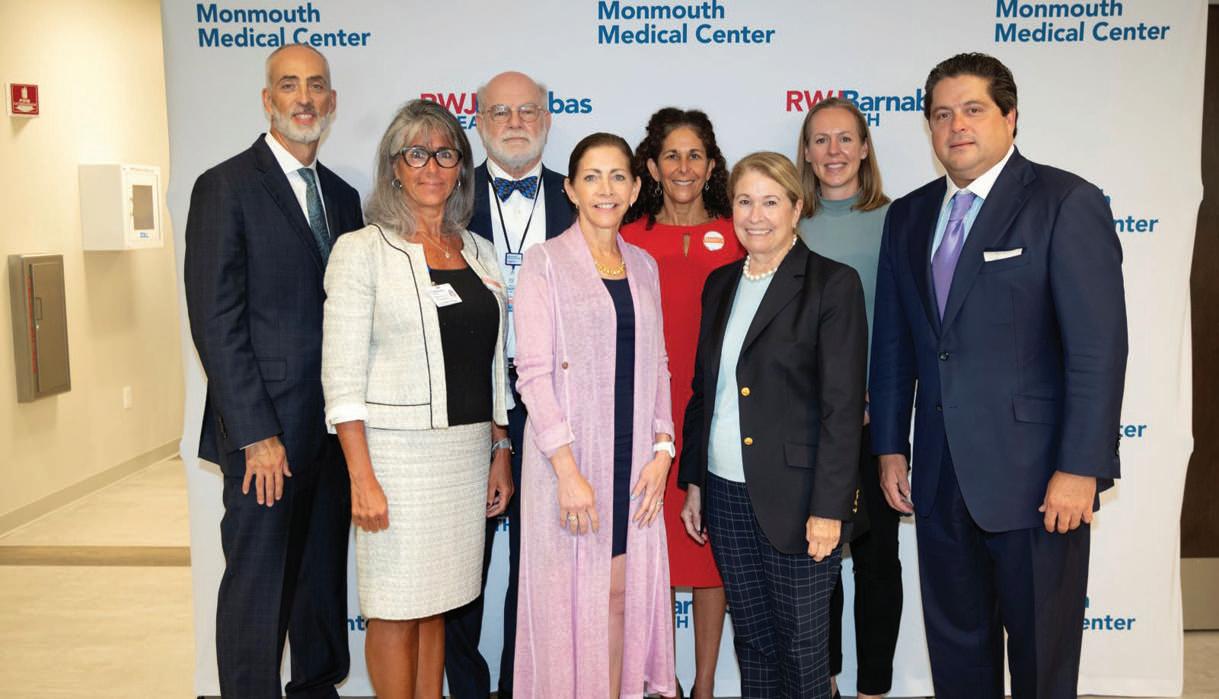
MMC is also a 5-Star Recipient for Vaginal Delivery, a distinction associated with a more than 45 percent lower risk of complications than in 1-Star hospitals.
MMC is also among 259 hospitals nationwide named to Money’s 2022 Best Maternity Hospitals based on data from an annual survey by The Leapfrog Group of more than 2,200 facilities.
we decided to have another baby, we would deliver at MMC. Everyone was understanding and accommodating. I never felt I wasn’t heard.”
To learn more about maternity services at Monmouth Medical Center, visit www.rwjbh.org/maternity
LEFT: Beneficiaries of the TeamBirth approach are Meredith (seated) and Nick (center) Picurro with their newborn son Steven, who wears a commemorative TeamBirth onesie, with (from left) Terry Tompkins, RN, and obstetrician-gynecologist Karen Smith, DO. Not pictured is Steven’s twin brother, Nicholas, who was being cared for in the neonatal intensive care unit at the time the photo was taken. RIGHT: At MMC’s TeamBirth NJ launch are (from left) Eric Carney, President and CEO, Monmouth Medical Center (MMC) and Monmouth Medical Center Southern Campus; Suzanne Spernal, Vice President, Women’s Services, RWJBarnabas Health (RWJBH); Robert Graebe, MD, Chair, Obstetrics and Gynecology, MMC; New Jersey First Lady Tammy Murphy; Linda Schwimmer, President and CEO, NJ Health Care Quality Institute; Judith Persichilli, Commissioner, New Jersey Department of Health; Amber Weiseth, Director, Delivery Decisions Initiative, Ariadne Labs; and Mark Manigan, President, RWJBH.
Monmouth Medical Center | RWJBH.ORG/MONMOUTH 5
As a lifelong resident of Tinton Falls and a cancer care leader, Deanna Tiggs, MS, RN, AOCNS, understands firsthand how the community will benefit from the planned Vogel Medical Campus.
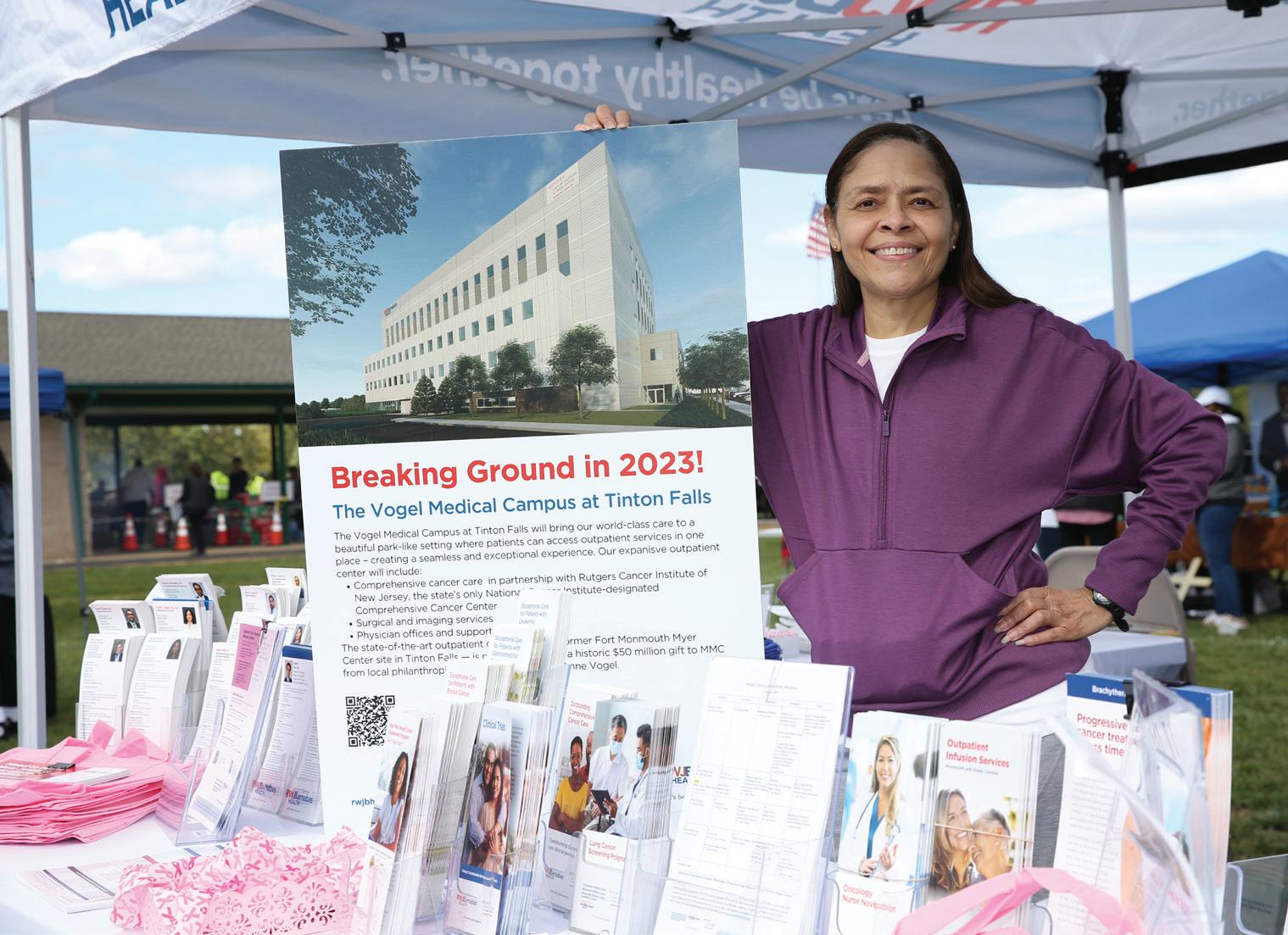
‘I’M VERY EXCITED’




Deanna Tiggs, MS, RN, AOCNS, has a unique perspective on plans to build the Vogel Medical Campus at Tinton Falls, a new stateof-the-art advanced care facility of Monmouth Medical Center (MMC): She is not only Director of Oncology Support Services, Southern Region, RWJBarnabas Health (RWJBH), but also a lifelong resident of Tinton Falls. The Vogel Medical Campus is named in recognition of a historic $50 million gift to MMC from local philanthropists Sheldon and the late Anne Vogel.
“I was born and raised here, and I’m very excited about the Vogel Medical Campus,” Tiggs says. “I look forward to it opening.” The new facility culminates decades of Tiggs’ personal and professional history.
She launched her career at MMC, starting as a registered nurse in 1984, quickly moving into cancer care, acquiring additional training in oncology as an advanced practice nurse and holding a number of positions over the years. Occasionally pursuing opportunities elsewhere, she continued returning to
RWJBH and today has responsibilities covering MMC, Monmouth Medical Center Southern Campus and Community Medical Center.

“I can also speak to care on a personal level,” Tiggs says. “My family in general has used MMC my whole life as our primary healthcare facility.” When her mother was diagnosed in 2020 with pancreatic cancer, Tiggs’ perspective shifted from provider to daughter. “I can say as a family member that the support and care my mother received was phenomenal from the minute she walked in the door,” Tiggs says.
EXPANDING WORLDCLASS CARE
The Vogel Medical Campus at Tinton Falls will extend MMC’s world-class care further into the community. Services that the four-story center will provide include comprehensive cancer care in partnership with Rutgers Cancer Institute of New Jersey, the state’s only NCI-Designated Comprehensive Cancer Center, along with surgical and imaging services, physician offices and more.
The facility addresses area changes Tiggs has seen over time. “Tinton Falls is still a family-oriented, close-knit community, but more densely
Monmouth Medical Center President and CEO Eric Carney (right), at the annual Tinton Falls Community Day with (from left) Tinton Falls Borough Council member Lawrence Dobrin, DMD, and Borough Administrator Charles Terefenko, says the new campus will bring world-class care to an easily accessible location. “The Vogel Medical Campus will be designed to provide an outstanding patient experience,” he says. “We are so incredibly grateful to the Vogels for their unparalleled support, and are proud of the confidence they placed in us to transform healthcare in Monmouth County.”

populated than when I was growing up,” she says. A local medical campus will provide residents even easier access to comprehensive, quality care near amenities such as shopping, restaurants and cultural attractions.
The Vogel Medical Campus will also embrace advances Tiggs has seen in the provision of cancer care. “Oncology clinical research is growing by leaps and bounds, as is supportive care programming, including integrative therapies that treat the mind as well as the body,” she says.
The campus will provide screening, prevention, education and outreach services such as those offered at the recently completed Anne Vogel Family Care & Wellness Center in Eatontown and will provide access to oncology clinical trials in collaboration with Rutgers Cancer Institute of New Jersey.
“It’s important that people don’t have to go to a city or metro area to receive advanced care,” Tiggs says. “The Vogel Medical Campus at Tinton Falls will be a brand-new facility in an attractive area and provide safe, comprehensive care and state-of-the-art equipment close to home. It will be a great asset to our community.”
A CANCER CARE LEADER LOOKS FORWARD TO A NEW MEDICAL CAMPUS IN HER HOMETOWN.
RWJBarnabas Health and Monmouth Medical Center, together with Rutgers Cancer Institute of New Jersey—the state’s only NCI-Designated Comprehensive Cancer Center—provide close-to-home access to the latest treatment options. For more information, call 844.CANCERNJ or visit www.rwjbh.org/beatcancer. To learn more about the Vogel Medical Campus, visit www.rwjbh.org/loveyourfuture
Healthy Together | 6 | Winter 2023
A BREAKTHROUGH TREATMENT FOR COPD

BREATHING EASIER THROUGH THE HEALTHY LIVES PROGRAM
MMC IS

FIRST HOSPITAL IN THE REGION TO OFFER A NEW VALVE THERAPY.
There’s new hope for people with emphysema, a progressive, lifethreatening lung condition and a severe form of chronic obstructive pulmonary disease (COPD). Emphysema has no cure, and patients live with severe shortness of breath that makes daily activities like walking or showering difficult.
Now Monmouth Medical Center (MMC) is the first hospital in the region to offer Zephyr Valves, a new lung valve treatment. Zephyr Valves received breakthrough device designation and were approved by the Food and Drug Administration in 2018 to help patients with severe COPD and emphysema breathe easier without many of the risks associated with major surgery.
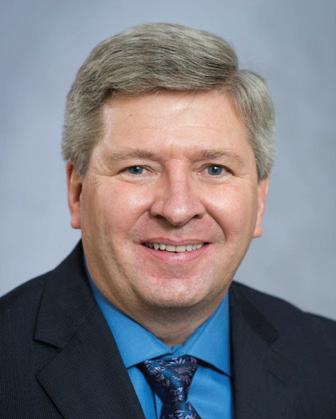
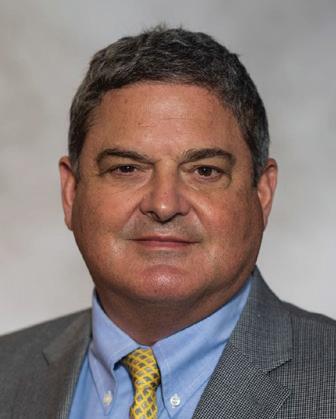
“Breathlessness is the most troubling symptom of severe emphysema—it can lead to depression, social isolation and a poor quality of life,” says Dean Patton,
MD, Chair of Medicine and Chief of Pulmonology at MMC and a member of RWJBarnabas Health Medical Group. “Patients with severe COPD and emphysema often struggle with each breath despite medication and oxygen therapy. Finally having a minimally invasive procedure to help these patients is very exciting.”
RELIEVING PRESSURE
Emphysema triggers extreme shortness of breath as air becomes trapped in parts of the lung damaged by the disease. Airfilled damaged areas become larger—a condition called hyperinflation that puts pressure on the diaphragm and makes breathing difficult.
With treatment using Zephyr Valves, a physician places an average of four valves to occlude airways leading to the targeted, hyperinflated part of the lung in a procedure that usually takes under an hour. The valves allow excess air to escape while blocking airflow into the treated area. Healthier parts of the lungs expand, relieving pressure, decreasing shortness of breath and allowing better breathing. Benefits have been shown to last at least one year after valve implantation.
“Prior to the introduction of this technology, the only treatment options for patients who failed nonsurgical

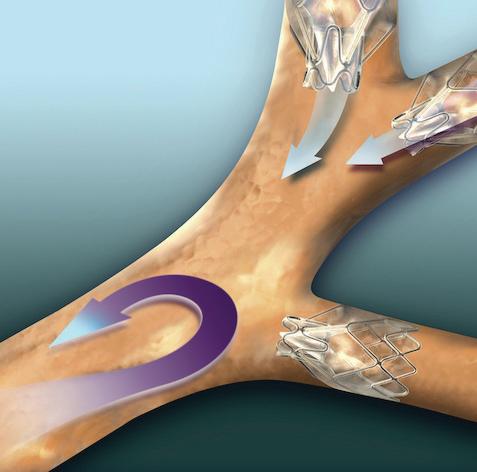
If you have severe COPD/ emphysema, help is available through the Healthy Lives Program at Monmouth Medical Center (MMC). The program is the newest addition to a full spectrum of cardiopulmonary services that bring together a multidisciplinary team of medical experts to monitor and manage conditions such as COPD, heart failure and pneumonia.
The patient-centered program is designed to prevent the need for emergency care or hospital readmissions. As part of the program, a nurse practitioner provides an initial assessment early in the disease process and continues working with patients and families to enhance their understanding of the condition and provide tools to manage it.
Elements of the Healthy Lives Program include cardiopulmonary rehabilitation; management of symptoms and risk factors such as high cholesterol or blood pressure; help complying with medication prescriptions; and access to services such as clinical nutrition, social services, ancillary tests and clinical trials.
Participation can begin when you’re an inpatient before hospital discharge, or you can be referred on an outpatient basis.
options such as pulmonary rehab were highly invasive treatments including lung reduction and lung transplant surgeries,” says Richard Lazzaro, MD, Southern Region Chief of Thoracic Surgery, who is teaming with Dr. Patton on the Zephyr program. “This breakthrough treatment is going to help us restore quality of life to so many residents in our region who struggle with breathing due to severe emphysema.”
To learn more about the Healthy Lives Program at Monmouth Medical Center or whether you’re a candidate for Zephyr Valves, call 732.923.6702 or visit www.rwjbh.org/monmouth
RICHARD LAZZARO, MD DEAN PATTON, MD
THE
Monmouth Medical Center | RWJBH.ORG/MONMOUTH 7
FAMILIES THAT GIVE TOGETHER

supporters of MMC’s nurses and are also funding a renovation of two new relaxation rooms at Monmouth Medical Center Southern Campus.
“I love to encourage staff to use Rita’s Room,” says Jessica D’Erasmo, RN, Assistant Clinical Director, Operating Room, at MMC. She recalls an instance when a new nurse had experienced a stressful situation during her shift. “She was in tears,” D’Erasmo says. “We had someone take her to Rita’s Room. She enjoyed the massage chair and came back to the unit feeling recharged. The room allows you to leave your work at work and not take stress home with you. It’s a true gift that we really appreciate.”
STEPPING UP
Creating a warm and welcoming environment for patients and visitors is a priority for the hospital, too. Recently the Kassin Escalator, which provides convenient access from the main lobby to Preadmission Testing Services, was named for a family that is committed to a multigenerational tradition of giving back to their community.
Family gifts that cross generations have had tangible benefits at Monmouth Medical Center (MMC)—for both patients and dedicated hospital staff members who serve them. Here are two recent examples.
A CALM HAVEN
Elisabeth Boone, RN, an operating room nurse at MMC, knows firsthand the value of Rita’s Room, a new relaxation suite for employees. “It’s a wonderful place where you can get away from everything and
decompress if you’re having a tough day,” she says. The suite features two massage chairs, yoga mats, dimmable lights, trickling water and a calm ambiance. “It’s very Zenlike,” Boone says.
The tranquil space is a gift to MMC staff from the Terracciano family in memory of their mother, Rita, who passed away in 2020 and is honored with a plaque that greets visitors as they enter the suite. A recent ribbon-cutting ceremony dedicated the room, which is open 24/7. The Terraccianos are longtime
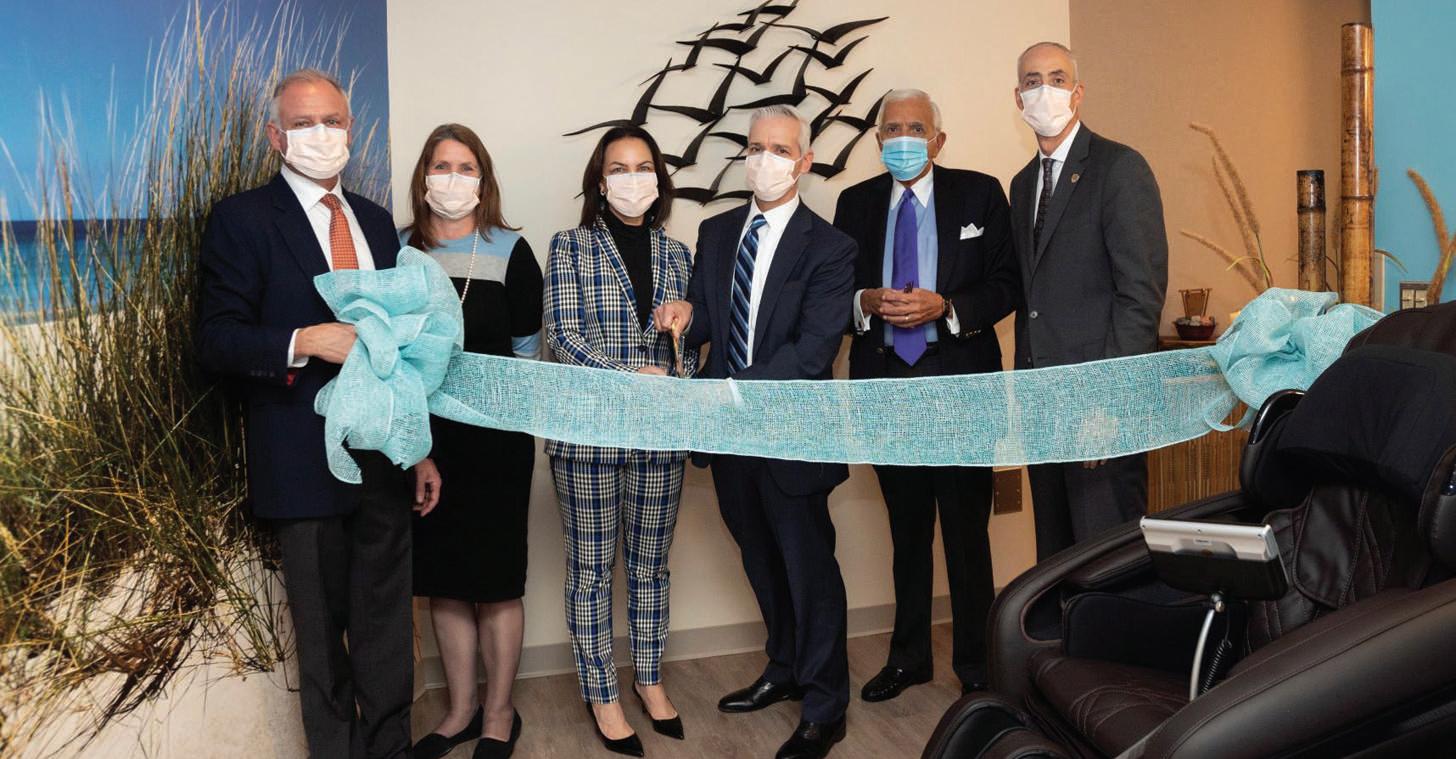
To learn how you can support the Monmouth Medical Center Foundation, visit www.rwjbh.org/monmouth-medical-center/giving
“The Kassin family gave a gift recently at our Tree of Life event in Deal,” said Caitlin Olson, Regional Vice President of Development for MMC and Monmouth Medical Center Southern Campus. “Their gift was announced at the start of the event and inspired many other community members to give to MMC.”
Jack and Joyce Kassin, along with their children and grandchildren, gathered recently at MMC for a ribbon-cutting ceremony to dedicate the escalator named for their family.
“During the dedication ceremony, Jack Kassin talked with his family about the importance of giving back to those that help you, and really emphasized to his children and grandchildren that it is important to help your community in any way you can,” Olson says. “We are so thankful for their generous support.”
TWO NEW SPACES IMPROVE CARE THANKS TO GENEROUS DONATIONS.
TOP: Members of the Kassin family and Monmouth Medical Center leadership including (left) President and CEO Eric Carney and (right) Regional Vice President of Development Caitlin Olson celebrate a multigenerational dedication of the Kassin Escalator. BOTTOM: Members of Rita Terracciano’s family, with Eric Carney (right), dedicate Rita’s Room—a calm, relaxing space where hospital staff can rejuvenate through features such as massage chairs and design elements that evoke nature.
Healthy Together | 8 | Winter 2023
SUICIDE WARNING SIGNS
Contact the RWJBarnabas Health Behavioral Health Access Center at 800.300.0628 for information about services or a referral to a mental health specialist.
HELP AND HOPE FOR THOSE AT RISK FOR SUICIDE
Suicide. It’s a scary word. According to the Centers for Disease Control and Prevention (CDC), close to 48,000 people in the U.S. died by suicide in 2020—that’s one person approximately every 11 minutes. You may have a family member or friend who is contemplating, or who has attempted, suicide—and chances are you don’t even realize it. There are several reasons for that.
• The warning signs are not always clear—and not every person exhibits them.
• The associated stigma is so widespread that many people in crisis are afraid or ashamed to reach out for help.
• There’s often a very brief period between thought and action. Studies have shown that nearly half of those who’ve attempted suicide did so within 10 minutes of first thinking about attempting.
Nobody knows this better than
Mark A. Graham, a retired U.S. Army Major General who serves as Executive Director, Rutgers University Behavioral Health Care (UBHC) and RWJBH Behavioral Health and Addictions Services, National Call Center and Vets4Warriors, which includes the New Jersey Suicide Prevention Hopeline (NJ Hopeline). One of his sons died by suicide in 2003 and since then, Maj. Gen. Graham and his wife, Carol, have been tireless champions of efforts to promote suicide-prevention awareness.
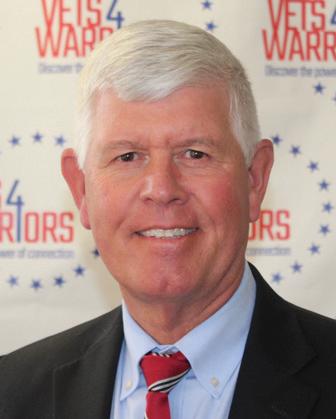
One in five adults in the U.S. (nearly 53 million people) lives with a mental illness. Yet, it still is not widely acknowledged as “real” sickness. “We’ve made some progress in changing that perception,” says Maj. Gen. Graham, “but we’re going to have the stigma until we make mental healthcare part of healthcare. Mental health is health.”
One of the goals of the NJ Hopeline, which launched a decade ago, is to make it easier for people contemplating suicide to seek help without fear of judgment. All NJ Hopeline employees have extensive training and are well

According to the National Institute of Mental Health, signs that a person may be thinking about suicide include:
Talking about:
• Wanting to die
• Great guilt or shame
• Being a burden to others
Feeling:
• Empty, hopeless, trapped or having no reason to live
• Extremely sad, anxious, agitated or full of rage
• Unbearable emotional or physical pain
Changing behavior:
• Making a plan or researching ways to die
• Withdrawing from friends, saying goodbye, giving away important items or making a will
• Taking dangerous risks such as driving extremely fast
• Displaying extreme mood swings
• Eating or sleeping more or less
• Using drugs or alcohol more often
prepared to help callers. “During a crisis, quick access to support and care can prevent death by suicide,” says NJ Hopeline Program Director William Zimmerman. “We listen, support and assess people for needs. There’s no time limit for a call, and we’re available 24/7. If we can keep that person engaged and supported, the suicidal action may never happen,” he says. Maj. Gen. Graham agrees. “The last thing we want to do is make a person regret that they called,” he says. “We want people to feel better, to know that there’s hope and help and that they’re not alone.”
If you or someone you know is experiencing warning signs of suicide, get help
Call 988 or NJ Hopeline at 855.654.6735 . For more information, visit
.
immediately.
rwjbh.org/behavioralhealth
A
ARMY MAJOR
AND HIS STAFF HELP PREVENT SUICIDE—ONE CALL AT A TIME.
RETIRED U.S.
GENERAL
MAJ. GEN. (RETIRED) MARK A. GRAHAM
RWJBarnabas Health | RWJBH.ORG 9
THE GREAT DEBATE:
CARDIO VS. STRENGTH TRAINING
Everyone knows that exercise is good for the heart. But what kind of exercise is most beneficial for optimum heart health—cardio or strength training? Anthony Altobelli III, MD, Clinical Chief of Cardiology, Robert Wood Johnson University Hospital (RWJUH) and RWJBarnabas Health (RWJBH) Medical Group, sheds some light on this decades-old debate.
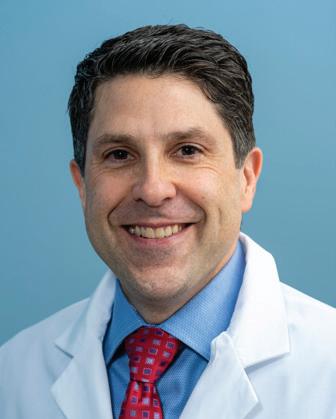
When it comes to cardio vs. strength training for heart health, is one more beneficial than the other?
The scientific evidence is still building around which form of exercise is best to prevent chronic disease. Historically, aerobic (or cardio) exercise was always recommended for heart and lung health with little attention paid to strength (or resistance) training. What’s clear now, however, is that strength training is as important to heart health as aerobic exercise and that a combination of both yields the best heart outcomes with regard to blood pressure, body composition,
fitness, strength and metabolism. In turn, beneficial change in a person’s physiology yields a lower risk of diabetes, hyperlipidemia (high cholesterol), heart attack and stroke.
What’s the best way to combine these exercises?
Physical Activity Guidelines for Americans , a 2018 report from the Department of Health and Human Services, recommends that each week, adults aged 18 to 64 do at least 150 to 300 minutes of moderate-intensity aerobic activity, 75 to 150 minutes of vigorous-intensity aerobic activity or an equivalent combination of both. Strength training should be performed at least twice a week on nonconsecutive days to allow a period of rest for the muscle groups being stressed.
How does age affect the type of exercise(s) a person should do?
As we age, safety becomes an issue. The aging adult should do both forms of exercise, but participation should take into account chronic medical conditions,
such as musculoskeletal disorders, that may place the individual at risk for injury. For people at risk for falls or with balance issues, resistance exercises, such as chair squats, heel lifts, rowing, resistance bands, bicep curls and shoulder presses, may be effectively and safely performed. Research continues to support strength/resistance training for older individuals.
What advice do you have for the average person who wants to start an exercise regimen to improve their heart health?
Recommendations are based on age and whether the individual is new to an exercise program. First, choose exercise that you may find enjoyable.
Second, set realistic expectations for how often and how long you’ll exercise. Third, choose exercises that you can safely perform.
Fourth, consider partnering with others for motivation and socialization. Fifth, communicate with your physicians.
ANTHONY ALTOBELLI III, MD
Whoever your heart beats for, our hearts beat for you. To connect with a top cardiovascular specialist at RWJBarnabas Health, call 888.724.7123 or visit www.rwjbh.org/heart. FIND OUT WHICH ONE IS BEST FOR YOUR HEART
HEALTH.
Healthy Together | 10 | Winter 2023
WORLD-CLASS CARE FOR BLOOD CANCERS CLOSE TO HOME
The Hematologic Malignancies Program at Rutgers Cancer Institute of New Jersey and RWJBarnabas Health is known in New Jersey and beyond for its world-class multidisciplinary team of cancer experts and for its coveted place at the forefront of cancer research. As the state’s only National Cancer Institute-Designated Comprehensive Cancer Center, it offers patients access to the most advanced treatment options for blood cancers, including blood and marrow transplantation, CAR T-cell therapy, immunotherapies and innovative clinical trials, many not available elsewhere.
Now, the highly regarded program
has extended its reach—and its potential—with the addition of two nationally recognized leaders in the field of hematologic malignancies to lead and complement the already outstanding team in place.

As the new Chief of Blood Disorders, Matthew Matasar, MD, MS, brings extensive expertise to the program and is among the nation’s most experienced clinicians and researchers in routine, rare and complex hematologic malignancies, with extensive expertise in treating these types of cancers with clinical trials, immunotherapy and other cellular therapies. Dr. Matasar will lead the enhancement of multidisciplinary clinical services, including programmatic growth of the bone marrow transplant and cellular therapy programs across the health system.
“My goal is to grow what already is an amazing program with extraordinary physicians,” says Dr. Matasar. “My vision is to continue to develop the health system’s ability to give best-in-class care; to deliver the most promising novel
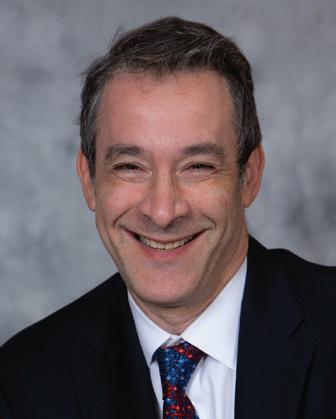
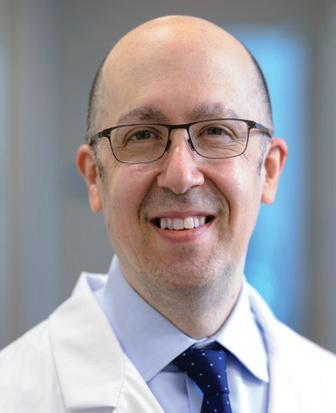
therapies in the context of ongoing and new clinical trials; to educate our patients, their families and the community; and to train physicians how best to take care of these patients.”
Ira Braunschweig, MD, Chief of Transplant and Cell Therapy, is an expert at treating blood cancers with blood and marrow transplantation as well as with CAR T-cell therapy, in which, he says, “We take the cells of a patient’s own immune system and reengineer them to become super-powerful cancerfighting cells.” Dr. Braunschweig was one of the physician-scientists leading the pivotal study in late 2015 that established CAR T-cell therapy as a standard for relapsed and refractory aggressive lymphoma.
“The Rutgers Cancer Institute/ RWJBarnabas Health program has a strong foundation,” he says. “I want to take it to the next level by expanding it and ensuring that more patients have these therapies available to them close to home, and by further enhancing the availability of cutting-edge therapies.”
To learn more about the Hematologic Malignancies Program at
Rutgers Cancer Institute of New Jersey/RWJBarnabas Health,
please visit www.rwjbh.org/beatcancer
MATTHEW MATASAR, MD, MS
CANCER DOCTORS ARE HELPING TO ENHANCE AND EXPAND THE HEMATOLOGIC MALIGNANCIES PROGRAM AT RUTGERS CANCER INSTITUTE
NEW JERSEY
HEALTH.
RENOWNED
OF
AND RWJBARNABAS
RWJBarnabas Health RWJBH.ORG | 11
IRA BRAUNSCHWEIG, MD
BETTER WOMEN’S HEALTH AT EVERY AGE
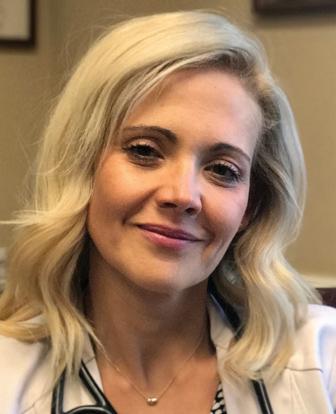

Throughout a woman’s life, her body and her healthcare needs evolve. From adolescence through menopause and beyond, women experience many changes. Staying healthy through all those changes can be daunting—but it doesn’t have to be. We asked doctors at RWJBarnabas Health to share some of their best advice on how women can maintain optimal

WHAT WOMEN NEED TO KNOW TO STAY WELL— FROM ADOLESCENCE TO AGELESS.
health at every age and stage.
PREVENTIVE AND GENERAL HEALTHCARE
Being proactive about preventing illness and injury should start early in a woman’s life. “Adolescent women should be encouraged to establish healthy eating and sleeping habits, exercise regularly and avoid excessive screen time,” says

Robert A. Graebe, MD, Chair and Program Director of the Department of Obstetrics and Gynecology at Monmouth Medical Center. Preventive care, he says, can include taking seemingly simple but important measures such as consistently using sunblock and always wearing a seat belt.
Dr. Graebe also stresses the importance of caring for mental health and says that adolescent and young women should be encouraged to seek support for feelings of anxiety and depression or other mental health problems. In addition, women should schedule an annual well-woman visit. “During this visit, the care you receive will focus on you, your body and your reproductive health,” says Dr. Graebe. “A well-woman visit also provides a time
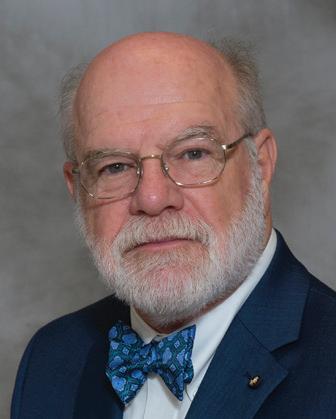 ROBERT A. GRAEBE, MD
LENA L. MERJANIAN, MD
NICOLE M. MONTERO LOPEZ, MD
ROBERT A. GRAEBE, MD
LENA L. MERJANIAN, MD
NICOLE M. MONTERO LOPEZ, MD
Healthy Together | 12 | Winter 2023
JULIE MASTER, DO, FACC
to discuss fertility questions and family planning options and to get screened for sexually transmitted diseases.”
GYNECOLOGIC AND REPRODUCTIVE HEALTH
• First OB/GYN Visits
“The American College of Obstetricians and Gynecologists recommends that a girl establish care with a gynecologist between the ages of 13 and 15,” says Lena L. Merjanian, MD, an obstetrician and gynecologist at Rutgers Health. “This visit is an opportunity for her to establish a trusting rapport with her physician. It’s a confidential visit to discuss reproductive health concerns, contraception, relationships, adolescent sexuality and avoiding risky behaviors.”
According to Dr. Graebe, the first OB/ GYN visit is also an opportunity to establish the diagnosis of common problems such as polycystic ovarian syndrome, hypothyroidism, eating disorders, etc. “The majority of bone formation occurs during the early years, so discussion concerning proper bone health is vital to prevent future osteoporosis,” says Dr. Graebe. A first gynecologic visit usually doesn’t include a pelvic exam or Pap smear.
• Reproductive Years
During a woman’s reproductive years, maintaining optimal health can increase her chances of a healthy pregnancy and birth if she chooses to start or grow a family. Folic acid supplementation is important, especially when planning a pregnancy. In addition, women should be proactive with age-appropriate screenings, such as Pap and HPV (human papillomavirus) tests. They should use condoms with new sexual partners to prevent sexually transmitted diseases, such as chlamydia and gonorrhea, which can negatively impact fertility. And, says Dr. Graebe, they should be aware that “a woman’s peak fertile years are from about age 27 to 29, with a steady decline starting in the mid-30s.”
Some women, including those receiving cancer therapies and those wishing to postpone pregnancy until beyond their mid-30s, may want to consider egg freezing and subsequent
HEALTH EQUITY
The importance of women’s health equity cannot be understated. According to Meika Neblett, MD, MS, Chief Medical Officer at Community Medical Center, “Women’s health equity requires an integrated approach that recognizes the need for progress in understanding the social determinants of health, diversity and inclusion, and their intersectionality.


MEIKA NEBLETT, MD, MS
“RWJBarnabas Health has made equity a priority in women’s health,” says Dr. Neblett, “and it has taken steps toward removing barriers to preventive screenings that lead to earlier diagnosis and treatment of certain types of cancers as well as improving access to family planning services.”
in-vitro fertilization, says Dr. Graebe.
• Breast Health
Breast self-awareness should start at about age 20, when women should focus on knowing what’s normal for their breasts. If changes are noticed, women should talk to their primary care provider or OB/GYN. Regular breast screening can help detect cancer at an early and more treatable stage. For women at average risk for breast cancer, a clinical breast exam is recommended every one to three years between the ages of 25 and 39, and a mammogram is recommended every one to two years beginning at age 40. “It’s important for women to be aware of their family history,” says Dr. Graebe. “Women at increased risk, such as those with a family history of breast cancer and other hereditary cancer syndromes, may benefit from seeing a genetic counselor.”
HEART HEALTH
“It’s important for a woman to know her risk factors for heart disease, including her cholesterol numbers, blood pressure, family history and smoking status,” says Julie Master, DO, FACC, Director of Noninvasive Cardiac Services at Monmouth Medical Center. “There are also novel risk factors such as pregnancy complications that can put a woman at
higher risk of heart disease in the future. A history of cancer treatment may also increase her risk. Having a yearly physical and not ignoring symptoms are of the utmost importance.”
BONE HEALTH
Most women don’t think about their bones until there’s a problem with them, but bones need care to stay healthy just like the rest of the body.
Bone density testing is one way to measure bone health. This is especially important for women because, according to Nicole M. Montero Lopez, MD, an orthopedist at Clara Maass Medical Center, hormonal changes during menopause can directly affect bone density. Women 65 and older and women under 65 with risk factors, such as a family history of the disease or fracture, should have a bone density test. Frequency of testing depends on age, results of prior tests and individual risk of fracture. The goal in osteoporosis prevention is to slow down the loss of bone mass to reduce the risk of fractures. You can strengthen your bones with certain exercises and lifestyle changes. Weight-bearing exercise is the most important type of exercise for preventing osteoporosis, and a diet rich in calcium and vitamin D is good for bone health.
To learn more about women’s health services at RWJBarnabas Health, visit www.rwjbh.org/treatment-care/womens-health
RWJBarnabas Health RWJBH.ORG | 13
CHILDREN’S CARE CLOSE TO HOME
WHERE TO TURN FOR SPECIALIZED OUTPATIENT SERVICES THROUGHOUT NEW JERSEY
As a leading provider of inpatient and outpatient care for children who face special health challenges from birth to age 21, Children’s Specialized Hospital, part of the RWJBarnabas Health Children’s Health Network of hospitals, partners with families to treat a wide range of developmental, physical, mental and behavioral concerns. You’ll find outpatient services close to home at these New Jersey locations.

HAMILTON
• Audiology
• Developmental and behavioral pediatrics
• Neurology
• Occupational therapy
• Physiatry
• Physical therapy
• Psychiatry
• Psychology
• Special needs primary care
BAYONNE
• Developmental and behavioral pediatrics
• Occupational therapy
• Physical therapy
• Speech and language therapy
CLIFTON
• Developmental and behavioral pediatrics
• Neurology
• Occupational therapy
• Orthopedics
• Physical therapy
• Psychology
• Speech and language therapy
EAST BRUNSWICK
• Occupational therapy specializing in upper extremity and hand therapy
• Physical therapy specializing in orthopedic and sports medicine
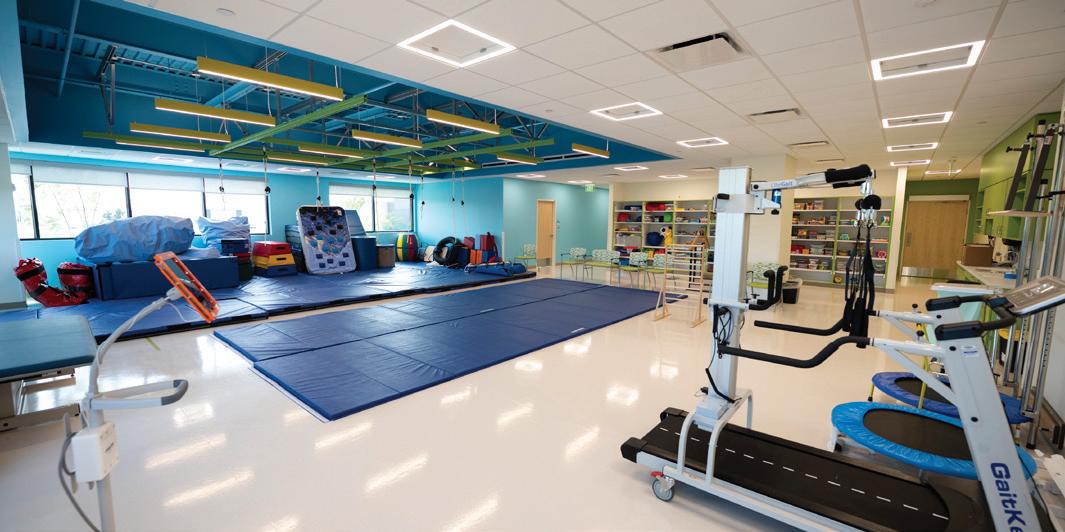
EATONTOWN
• Audiology
• Developmental and behavioral pediatrics
• Neurology
• Occupational therapy
• Physiatry
• Physical therapy
• Psychology
• Speech and language therapy
EGG HARBOR TOWNSHIP
• Developmental and behavioral pediatrics
• Occupational therapy
• Physiatry
• Physical therapy
• Psychiatry
• Psychology
• Speech and language therapy
• Speech and language therapy
NEWARK
• Developmental and behavioral pediatrics
• Occupational therapy
• Physical therapy
• Speech and language therapy
NEW BRUNSWICK— PLUM STREET
• Developmental and behavioral pediatrics
• Neurology
• Neuropsychology
• Occupational therapy
• Physiatry
• Physical therapy
• Psychiatry
• Psychology
• Speech and language therapy
TOMS RIVER— LAKEHURST ROAD AND STEVENS ROAD
• Audiology
• Developmental and behavioral pediatrics
• Neurology
• Nutrition
• Occupational therapy
• Physiatry
• Physical therapy
• Psychiatry
• Psychology
• Rehabilitation technology
• Speech and language therapy
UNION
• Audiology
• Developmental and behavioral pediatrics
• Neurology • Neurorehabilitation
• Occupational therapy
• Orthopedics
• Physiatry
• Physical therapy • Psychiatry • Psychology
• Special needs primary care • Speech and language therapy
SOMERSET
• CSH RUCARES Severe Behavioral Program
• Intensive Feeding Disorders Program
WEST ORANGE
• Occupational therapy
• Physical therapy
• Speech and language therapy
To learn more about outpatient programs and services or to schedule an appointment, call 888.244.5373 or visit www.rwjbh.org/cshoutpatient At Children’s Specialized Hospital, we provide world-class care for children and young adults who face special health challenges across the state of New Jersey and beyond. We treat everything from chronic illnesses and complex physical disabilities, like brain and spinal cord injuries, to a full scope of developmental, behavioral and mental health concerns. We have convenient locations throughout the state: Bayonne, Clifton, East Brunswick, Eatontown, Egg Harbor Township, Hamilton, Newark, New Brunswick, Somerset, Toms River, Union and West Orange.
Outpatient services include facilities and equipment specially designed to meet children’s needs. Healthy Together | 14 | Winter 2023
An RWJBarnabas Health facility
BEYOND BED-WETTING
A TOP PEDIATRIC UROLOGIST SHARES THE LATEST TREATMENTS FOR URINARY TRACT PROBLEMS IN CHILDREN.
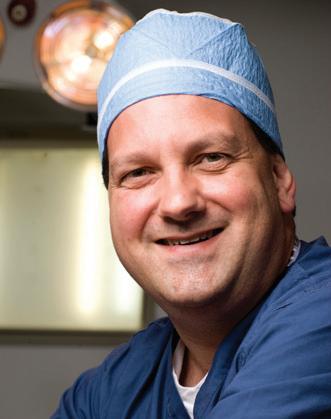
Joseph Barone, MD, a nationally recognized expert in the field of pediatric urology, was recently appointed Medical Director of Pediatric Urology for the Children’s Health Network of RWJBarnabas Health (RWJBH). Dr. Barone is also Chief of the Division of Urology and Professor of Surgery at Rutgers Robert Wood Johnson Medical School. Here, Dr. Barone talks about children’s urologic conditions as well as what’s new in the field.
How has the RWJBH pediatric urology program changed recently?
We’re now a system-based program with all pediatric urologists in all RWJBH children’s hospitals working as one group. This allows us to take advantage of
synergistic opportunities for clinical access, safety, quality and diversity. With integration, patients will receive the same pediatric urology care no matter where they are in the system.
How are children’s urologic issues different from those of adults?
Children mostly have congenital problems and adults deal with problems that develop during life. Because of this, the practice of pediatric urology now has its own board certification by the American Urological Association.

What are some common urologic issues in children?
The most common is bed-wetting, affecting 10 million children in the United States each year. Other
common conditions include urinary tract infections (UTIs) and daytime accidents. There are also some common surgical conditions, such as undescended testes and hernia.
What are some serious pediatric urologic conditions that you treat? Some children born with neurological diseases, such as spina bifida, lack the nerves that control the bladder. As a result, they’re incontinent. To restore continence, we use the small intestine to make a new bladder with a procedure called bladder augmentation. Twisting, or torsion, of the testes—when a boy’s testicle twists spontaneously and cuts off its blood supply—is another serious issue that not many people know about. Sudden, severe testis pain is an emergency and parents should take their child to the emergency department if this happens.
What robotic surgical techniques are used for children?
We offer minimally invasive robotic surgery for nearly all pediatric urology conditions that historically would require an incision. The robot is controlled by the surgeon, and three or four laparoscopic ports are placed into the child’s abdomen. Robotic surgery speeds recovery and results in less pain. For older children, we offer singleport robotics. There are only a handful of centers that offer this robotic procedure.
Are there any exciting new developments in this area?
We’re working on developing a new electrical surgical tool designed for pediatric surgery. We currently use similar tools designed for adults and when working in a very tiny space, they can be cumbersome. We’ve designed the pediatric surgical tool and are in the process of making a 3D model.
To find a pediatric urologist or for more information on children’s urologic issues, visit www.rwjbh.org/childrenshealth
JOSEPH BARONE, MD
RWJBarnabas Health RWJBH.ORG | 15
BANKING ON LIFE
WHERE AND HOW TO DONATE BLOOD THIS WINTER
It’s estimated that someone in the United States needs blood every two seconds, and, since January is National Blood Donor Month, there couldn’t be a better time to donate. Blood doesn’t have a long shelf life—between five and 35 days, depending on the component—so there’s rarely, if ever, a surplus. This is especially true in winter, when donations typically slow down because of bad weather, winter holidays and seasonal illnesses like colds and flu.
“Simply put, there’s no substitute for blood,” says Sally Wells, Business Development Liaison, Robert Wood Johnson University Hospital Blood Services. “Blood cannot be manufactured. We always say that ‘it’s the blood on the shelf’ that makes it possible to treat traumatic injuries, perform surgeries, support premature babies and treat patients who are going through advanced cancer therapies, to name a few of its uses.”
While all RWJBarnabas Health facilities run blood drives several times
a year, Wells says that multiple blood drives will occur in January, noting that donor centers in New Brunswick and Somerset will be open daily. “Our message for National Blood Donor Month is ‘Donate 3 in 2023,’” she says, referring to three pints of blood.
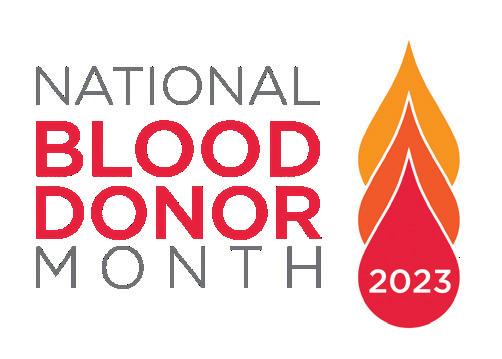
The ripple effect of the pandemic is still being felt in many areas, including blood donation. “People aren’t donating as often as before the pandemic, so we’re still experiencing periodic shortages,” says Wells. “We haven’t been able to build up a reserve, so certain blood types and products are always in high demand.”
The blood type that is most in demand is type O-negative (O-). “This is the universal blood type because it can be used in an emergency to transfuse anyone until the person’s blood type can be verified,” says Wells.

If you don’t know your type, don’t worry. When you donate, you’ll be issued a blood-donor card that will list your blood type.
HOW TO DONATE
The four basic steps to donating blood are:
1. Registration (to gather demographic information)
2. Medical interview and mini physical (to determine if the donor is suitable)
3. Phlebotomy (the actual donation, drawing blood)
4. Rest and refreshments (after blood is donated)
REQUIREMENTS FOR DONORS
To donate blood, you must:
• Be in overall good health
• Be at least 17 years old (16 with parental consent)
• Weigh at least 110 pounds (120 pounds if 16 years old)
• Present a valid photo identification with signature
For more information or to schedule an appointment to donate blood, visit www.rwjbh.org/treatment-care/blood-donation or
or call 732.235.8100 ext. 221 (New Brunswick) or 908.685.2926 (Somerset).
www.rwjuhdonorclub.org ,
Healthy Together | 16 | Winter 2023
Brianna Sherman (right) acts out a psychodrama scene speaking with her future self, assisted by (left) Chelsea, another program participant, and (center) facilitator Sandra Smith, MA, LCADC, CSW, CP. Brianna wears a fabric that helps with role-reversal exercises.
ACTION THERAPY
IN PSYCHODRAMA, PARTICIPANTS USE CREATIVE SCENARIOS TO ADDRESS EMOTIONAL ISSUES.
Imagine you have unfinished emotional business that you don’t know how to address. The issue might pertain to a fear, thought pattern or relationship—perhaps with a parent, a former teacher, an abuser or even a pet. It’s hard to know what to think or say, especially if the focus of your difficulty is no longer available or has died.
A type of therapy called psychodrama can help. Offered through the outpatient Pollak Clinic at Monmouth Medical Center (MMC), the program serves patients who often have challenges with depression, anxiety, bipolar disorder, post-traumatic stress disorder and other mental health issues.
“Psychodrama is action-oriented group therapy,” says Sandra Smith, MA, LCADC, CSW, CP, a certified practitioner in psychodrama, sociometry and group psychotherapy with the Acute Partial Hospital Program in Outpatient Behavioral Health at MMC. “The goal is to better understand relationships or move forward if you feel stuck. We work to provide stability, structure and
support so people can improve their functioning and quality of life.”
DEVELOPING TRUST
The therapy’s combination of psychology and drama uses a variety of creative tools including representative props such as pictures and fabrics, role playing, imagined conversations and creative arts such as music and poetry.
In a concept called surplus reality, a person can, for example, revisit a scene from the past or have conversations with their future self, people from childhood or even animals. Other participants in the group take on roles to help a patient have dialogues that can often reveal unappreciated perspectives or get feelings out in the open.
Brianna Sherman, a 23-year-old psychodrama participant, was able to work through grief she had from having
HOW PSYCHODRAMA HAS HELPED
Participants in the psychodrama program at Monmouth Medical Center’s Pollak Clinic speak about what they’ve gained from the actionoriented group therapy.

“Through role playing, I am able to explore my feelings in various and complicated situations. I can then come up with creative solutions for complex emotional scenarios.” – Chelsea
“Psychodrama has provided a safe and creative space to help work through difficult situations in my life. It is a healing journey like no other.” – Meaghan
“Psychodrama is a powerful type of therapy that I never experienced or heard of before coming to treatment. It has helped me deal with negative thoughts and get my feelings out. I wish I had known about it years ago.” – David
“My group members tell me how much playing a role has helped them. It has also helped me be more open.” – Luis
“Genuine healing has occurred through my participation in this very unconventional yet powerful and effective action-oriented therapy. I’m very grateful for the positive changes that psychodrama has helped me enact in my daily life. I’m a true believer.” – Renee
to put down a beloved 13-year-old dog. “I got the dog as a teen, and working through my grief helped me open up about my biggest issue,” she says. “When I was able to see I could be emotionally vulnerable about an animal close to my heart, I realized I could trust the therapist with other things deep within me. After most sessions, I leave with some sense of peace or relief. It’s very healing.”
“Psychodrama can be cathartic,” Smith says. “Just being able to express emotions like anger or sadness can be very powerful.”
To learn more about outpatient mental health services at Monmouth Medical Center, call 732.923.6500
Monmouth Medical Center RWJBH.ORG/MONMOUTH | 17
BACK ON THEIR FEET

Healthy Together | 18 | Winter 2023
More than 800 knee and hip replacement surgeries are performed each year at the Joint Replacement Center at Monmouth Medical Center (MMC), where a specialized team uses state-of-the-art surgical technology to optimize patients’ recovery and get them back to healthy, active lives.
Knee replacement surgery can help when more conservative treatments such as medication, physical therapy, injections and bracing don’t successfully relieve pain or restore function, explains David Chalnick, MD, Medical Director of the Joint Replacement Center. “When your quality of life is affected to the point that simple things like getting out of a car, climbing stairs, walking or going to the supermarket are difficult, that’s when we recommend knee surgery,” he says.
Here’s how two women benefited from following that advice.
AN AUDIBLE SNAP
As a union painter for Hamilton Township schools, Sherry Gans is on her feet most of the day, so she has to be fit and mobile. She’d already had surgery to repair the anterior cruciate ligament (ACL) in each of her knees in the past.
But in March 2021, the 55-year-old Toms River resident was hauling fivegallon paint cans from her van into the paint shop when she felt and heard a snap in her left knee. “Everyone around me heard it, too,” she says. “It was incredibly painful.”
She underwent another arthroscopy—a minimally invasive procedure that accesses structures inside the knee—in what was to be a staged, two-part reconstruction of her ligament. But the joint had degenerated so much due to wear and tear of arthritis that it was beyond repair. Following the attempted reconstruction, “my knee kept filling up with fluid,” Sherry says. “I was trying to
work and just couldn’t, I had so much pain and instability.”
Sherry was referred to Dr. Chalnick to convert the ACL repair to a full knee replacement. After COVID-related delays, Sherry had surgery in June 2022. “Dr. Chalnick explained exactly what would happen and prepared me for everything,” she says. “I’ve had a lot of surgeries in my life, and he is the best surgeon and best communicator I’ve ever had. He knew I really wanted to go back to painting and didn’t want this to be the end of my career, so he told me I’d have to work hard at physical therapy [PT] after surgery.”
Kept overnight at the hospital, she left impressed with MMC’s staff, rooms and food. “I’ve never had such a good surgery and hospital stay,” she says. “I truly felt like I was in a 5-star resort.”
Sherry then began a two-week, athome PT regimen. Initial pain gave way to greater strength and function. “My physical therapist pushed me as far as I needed to be pushed,” she says, “but not too far.” She soon made plans to start working again.
Today, Sherry’s range of motion has been completely restored. “My leg extension is impeccable,” she says. “I still have a little pain sometimes, but I’m able to do almost everything.”
Even more important to Sherry, surgery allowed her to be physically active with her close-knit family, most of whom live nearby. “My 5-year-old greatnephew kept asking when I could run and chase him again,” she says. “I’d tell him, ‘Pretty soon now, pretty soon!’ I’m just so thankful for Dr. Chalnick. He was my saving grace.”
‘TIME TO MAKE A DECISION’
Mary Ann Battista’s job as an event planner for the financial industry often involved walking—and, increasingly, knee pain. “I work in very large resorts, and we’re always on our feet,” she says.
When the COVID-19 pandemic put a halt to in-person meetings, she worked remotely from home, which took less of a toll on her knees. Already considering surgery, she was able to put it off. But when pandemic restrictions eased, her reprieve ended.
“In October 2021, I worked my first in-person meeting again,” she says. “From that time on, the meetings kept ramping back up and the pain just got worse.”
One day in June 2022, while she was walking into a coworker’s office, her knee buckled, and she fell. “I already had an appointment with Dr. Chalnick scheduled for the next week,” she says. “I showed him the bruise, and he said it was time to make a decision.” She had already failed conservative treatment, so she proceeded with her total knee replacement in July.
Like Sherry, Mary Ann went home the day after her surgery at MMC to begin two weeks of at-home PT, working through some initial post-op pain and swelling. “But I kept with my therapy, and by the beginning of September, I was back to doing laundry and getting my independence back,” she says. Not long after, she could once again drive and return to work.
“Dr. Chalnick is a great surgeon and human being who really cares about his patients,” she says.
Newfound mobility improves personal as well as professional lives. Mary Ann and her husband looked forward to rejoining many activities they enjoy with friends in their community such as attending events with a local wine club.
“Once they get through the process, most people are very happy they had total knee replacement and wish they had done it sooner,” Dr. Chalnick says. “The best part of my job is that every day, people thank me for giving them back their quality of life.”
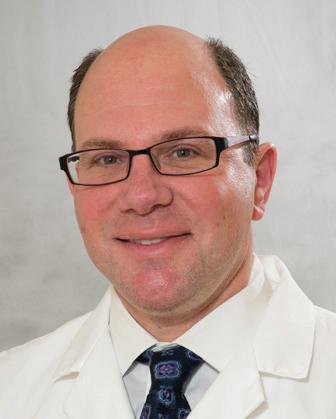
To learn more about knee replacement surgery at Monmouth Medical Center, call 888.724.7123 or visit www.rwjbh.org/ortho KNEE REPLACEMENT SURGERY ALLOWS TWO WOMEN TO LIVE THEIR BEST LIVES. Monmouth Medical Center RWJBH.ORG/MONMOUTH | 19
DAVID CHALNICK, MD
‘MOTILITY DISORDERS CAN BE SERIOUS’
Gravity does some of the work moving food and liquid down the chute-like esophagus into the stomach. But muscles on the way also contract to give the esophagus its own motion, or motility, to move things along. If you notice you have trouble swallowing or keeping food and liquid at the back of your throat, you may have a motility disorder.
“Esophageal motility disorders can be serious, and anyone experiencing them should see a doctor,” says Dmitry Oleynikov, MD, FACS, Chair of the
Department of Surgery at Monmouth Medical Center (MMC) and a member of RWJBarnabas Health Medical Group.
“We have many tools at our disposal, including advanced options for diagnosis and treatment.”
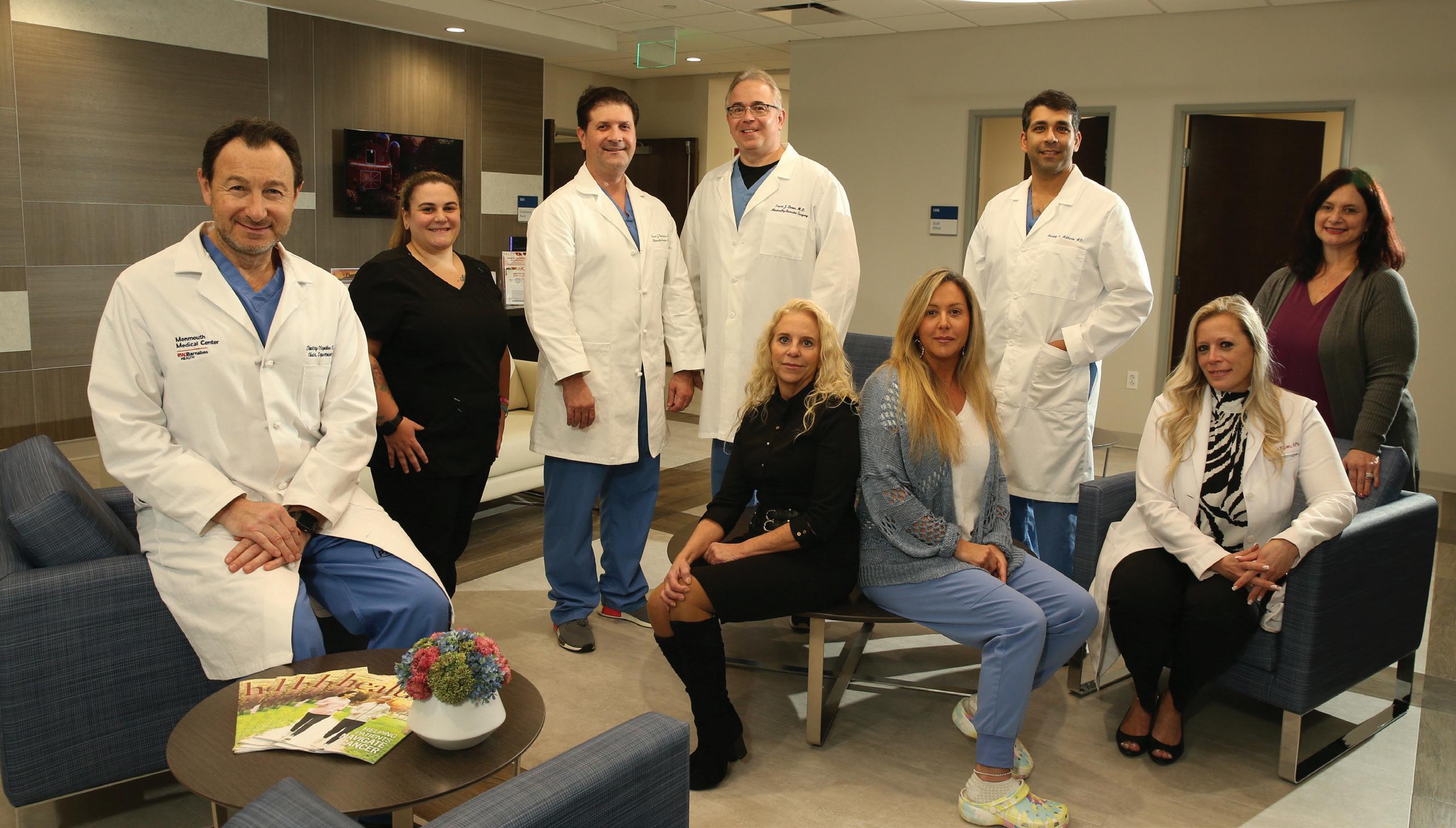
Here are key facts you should know about esophageal motility disorders and how to resolve them.
MOTILITY DISORDERS HAVE MANY
CAUSES.
A swallowing problem called dysphagia can result from the esophagus working
too hard or not hard enough. Spasms may prevent food from moving down. The esophagus may become inflamed, leading to narrowing and strictures. Or esophageal muscles may become weak so they’re less able to propel food.
In a disorder known as achalasia, neurologic problems prevent the esophagus from squeezing and pushing material down the esophagus and can prevent the lower esophageal sphincter—a valvelike structure between the esophagus and stomach—from working properly.
TO KNOW ABOUT SWALLOWING DIFFICULTY, REFLUX AND OTHER PROBLEMS OF THE ESOPHAGUS Healthy Together | 20 | Winter 2023
WHAT
With gastroesophageal reflux disease (GERD), the lower esophageal sphincter weakens and allows stomach acid and food contents to come back up the throat. Being overweight can trigger GERD by increasing pressure on the abdomen, and GERD is becoming more prevalent with rising obesity rates, says Dr. Oleynikov. GERD can also result from a hiatal hernia, in which part of the stomach bulges through an opening in the diaphragm between the stomach and chest.
Other conditions that can cause esophageal dysfunction include Chagas disease, a parasitic infection most commonly found in Latin America, and underlying health issues such as scleroderma and rheumatoid arthritis.
SYMPTOMS VARY.
Different underlying causes can trigger a range of symptoms. Signs of a motility disorder include difficulty swallowing, chest pain and discomfort, regurgitation, acid reflux, heartburn, vomiting, weight loss, poor sleep and anxiety. Occasional symptoms may not bother some people, but persistent, recurring symptoms can become disruptive and interfere with proper nourishment.
PREVENTIVE STEPS MAY HELP. Not all esophageal motility disorders are preventable. But it’s possible to avoid conditions such as GERD by having a healthy lifestyle that steers clear of risk factors such as smoking, drinking too much alcohol, consuming spicy or fatty foods, eating large meals or eating late at night. “If needed, we can help manage obesity surgically,” Dr. Oleynikov says.
TREATMENTS DEPEND ON CAUSE.
A range of treatments for underlying conditions are available at MMC’s Complete GI Motility and Reflux
Program and its Center for Minimally Invasive Esophageal and Gastric Surgery. Solutions range from medication to surgery and often use advanced, state-of-the-art endoscopic technology.
One example is the Endoflip Impedance Planimetry System, which allows doctors to measure esophageal function while a patient is asleep. “This is a new technology that is much better for assessing certain disease processes and is more pleasant for patients compared to standard methods that entail inserting a catheter through the nose while the patient is awake,” Dr. Oleynikov says.
Specific treatments address specific triggers. For achalasia, doctors can open the lower esophageal sphincter through an endoscopic or robotic procedure and may rebuild the valve to prevent reflux. Hiatal hernias can be repaired laparoscopically or robotically. GERD patients can take medications such as proton pump inhibitors (PPIs) and make dietary and lifestyle changes.
MOTILITY SYMPTOMS SHOULD BE EVALUATED.
If you have chest pain, call 911 or go to the emergency department; if the pain isn’t explained by a heart condition, it could be an esophageal motility disorder. If heartburn occurs more than two or three times a week and over-thecounter medications don’t help, consult a physician to get the condition under better control.
“Likewise, if you’ve been taking a PPI and still need it after one to three months, you should consult your doctor,” Dr. Oleynikov says. “And any time you have trouble swallowing, seek medical attention for evaluation and proper treatment. Many advanced procedures are available to resolve these common conditions.”
A ONE-STOP PROGRAM
“When you look at people who have esophageal motility disorders such as heartburn and difficulty swallowing, you see a pattern,” says Dmitry Oleynikov, MD, FACS, Chair of the Department of Surgery at Monmouth Medical Center (MMC) and a member of RWJBarnabas Health Medical Group. “These patients are often obese and less healthy, and there tends to be not just one thing wrong but multiple things.”
That’s why MMC’s Complete GI Motility and Reflux Program in the new Anne Vogel Family Care & Wellness Center offers multidisciplinary, comprehensive care that includes bariatric, or weight loss, surgery. Bariatric surgery often helps resolve underlying causes of motility disorders when lifestyle measures alone aren’t enough.
“We want to provide one-stop care for patients rather than sending them to different places for different problems,” Dr. Oleynikov says. “Our program offers all the services you need for whole-body wellness, including community-based education programs in the Anne Vogel Center’s LiveWell Center.”
To learn more or to schedule an appointment at the Complete GI Motility and Reflux Program, call 732.923.6070
From left at the Anne Vogel Family Care & Wellness Center are Dmitry Oleynikov, MD, Chair of Surgery at Monmouth Medical Center; Katlyn Tipton, CMA; bariatric surgeons Steven Binenbaum, MD, and Frank Borao, MD, Medical Director, Center for Bariatrics at MMC; Michele Taylor, OR Scheduler; Joanne Leader, RN; bariatric surgeon Gurdeep S. Matharoo, MD; Lisa Ryan, APN, Advanced Practice Nurse with the Center for Bariatrics; and Nydia Delgado, Practice Administrator.
Monmouth Medical Center RWJBH.ORG/MONMOUTH | 21
‘I’M VERY, VERY thankful’
What happened to Debora Edwards shows how the procedure known as angioplasty or percutaneous coronary intervention (PCI) can save lives—and prevent devastating losses to families.
In September 2019, the now-51-yearold Rumson resident was rushed to Monmouth Medical Center (MMC) with a heart attack. Three years later, in an emotional reunion outside the hospital’s

Emergency Department (ED), she was finally able to thank a doctor who had been part of a team that kept her alive.
“All I could think about in the ambulance three years ago was my husband and kids, who were 12 and 9 at the time,” Debora says. “Now when I look at my children, I remember that without the wonderful professionals who saved my life that day, I would not be here to raise my family.”
A DIRE EMERGENCY
Debora had felt sluggish and tired for a few weeks, but the heart attack otherwise came out of the blue. “I’m active, eat a pretty good diet and had no history of heart problems,” she says. “I went from feeling OK to having a full blockage in a matter of minutes.” A friend who happened to be visiting called 911.
The sight of the emergency team at the door of MMC’s ED stands out in Debora’s memory. “It brought this sense of peace
THE CARDIAC PROCEDURE THAT SAVED A WOMAN’S LIFE IS NOW AVAILABLE TO MORE PATIENTS.
Healthy Together | 22 | Winter 2023
Debora Edwards embraces emergency medicine physician Harisios Tjionas, DO, outside Monmouth Medical Center, where she had arrived near death three years earlier. The reunion allowed her to offer thanks along with (left, from left) her children, Melissa, 12, and Matthew, 16, and her husband, Steven.
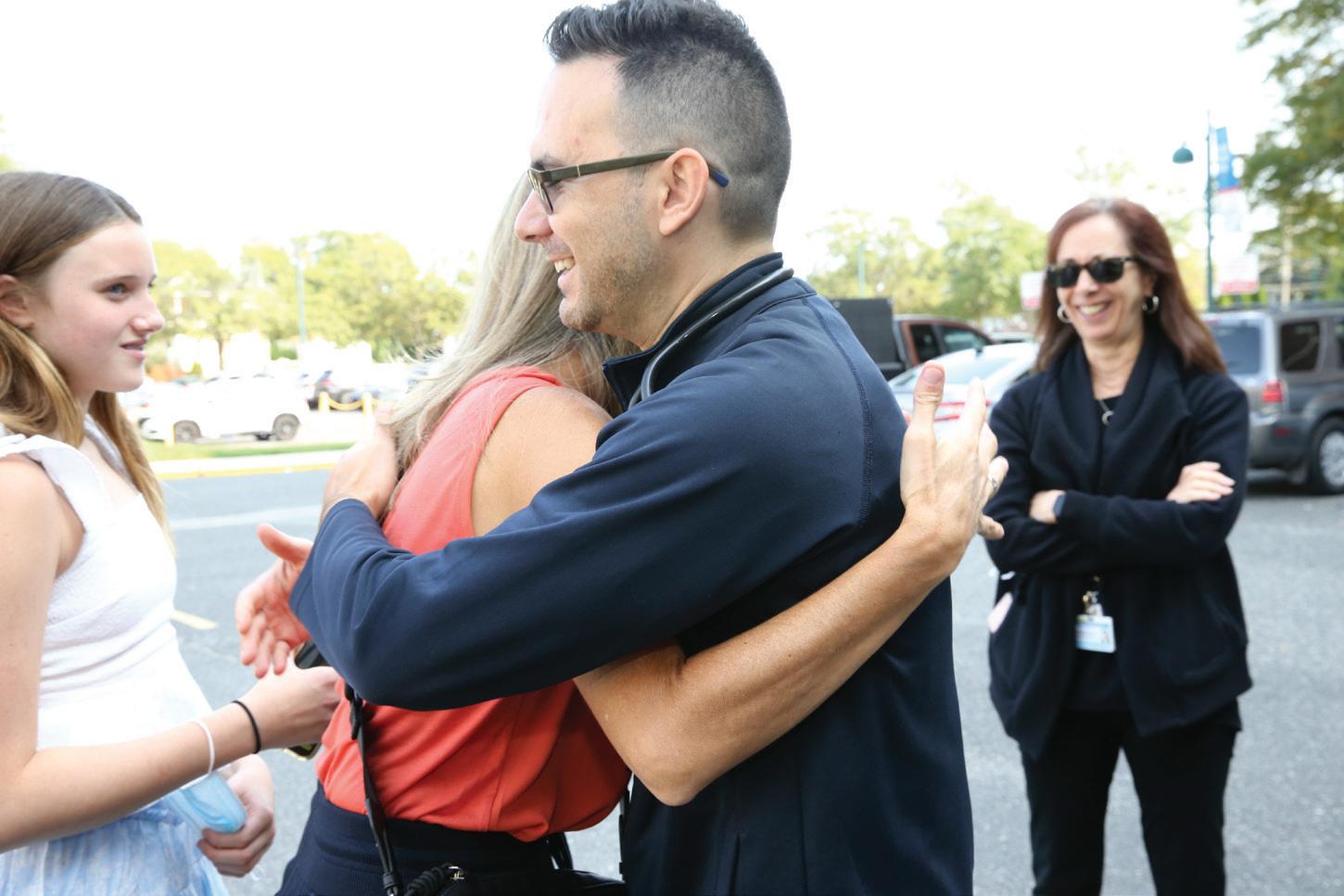
and trust when I saw everybody waiting and ready,” she says. “It meant a lot.”
“I remember that day well,” says Harisios Tjionas, DO, an emergency medicine physician at MMC and a member of RWJBarnabas Health Medical Group, who is the doctor Debora reunited with in 2022. “She went into a dangerous arrhythmia called ventricular fibrillation where the heart quivers in a chaotic fashion. She was in cardiac arrest, with no heartbeat or blood pressure, no pulse, no cardiac output. That happened right in front of our eyes. Had she come five or 10 minutes later, she might not have made it.”
Debora’s heart attack was caused when the inner layer of a damaged coronary artery peeled off, or dissected, and blocked blood flow. This relatively uncommon type of blockage, called spontaneous coronary artery dissection (SCAD) due to fibromuscular dysplasia (FMD), is more prevalent in women than men, and those affected are often comparatively young. Debora’s SCAD occurred in the left anterior descending artery, which supplies two-thirds of blood going to the heart.
888.724.7123 or visit www.rwjbh.org/heart.
procedure used to open blocked arteries that deliver blood to the heart and, if needed, keep blood vessels open with expandable stents.
“Everything happened very quickly,” Debora says.
can fix them in the same procedure,” Dr. Tawfik says. “Previously, we would need to transfer a non-emergent patient to a different hospital authorized to do elective angioplasty. Essentially, the patient would need to have a second procedure to fix the problem we had identified.”
“Having a heart attack in this area is sometimes described as a widowmaker,” says Isaac Tawfik, MD, Chief of Cardiology and Medical Director of the cardiac catheterization (cath) lab at MMC, and a member of RWJBarnabas Health Medical Group. “It’s very serious.”
The emergency team revived Debora and quickly sent her to the cath lab. There, an interventional cardiology team performed her angioplasty, a minimally invasive
Once Debora was stabilized, doctors anticipated she would need coronary bypass surgery, and she was taken to Robert Wood Johnson University Hospital in New Brunswick. “I spent a few days in intensive care, and they prepared me for bypass,” she says. “But thankfully, I bounced back really quickly, and doctors determined I didn’t need it at that time.”
EXPANDING CARE
For decades, MMC has performed emergency (or, in medical parlance, emergent) angioplasties on patients experiencing the most critical types of heart attack. Now the hospital has received state approval to perform nonemergent angioplasty procedures on an elective basis as well.
“This means that if patients who are less acute come to the hospital for, say, chest pain or an abnormal stress test or worrisome enzyme levels, we not only can do the catheterization to assess their arteries, but if we find blockages, we

A 58-year-old Long Branch man was the first MMC patient to receive an elective angioplasty. He didn’t have a heart emergency but came to the hospital with chest pain and difficulty breathing. When testing revealed multiple occlusions in his arteries, he was able to receive his PCI procedure close to home from the same care team. “I’m feeling 100 percent better,” he says. “I can move better and have more stamina.”
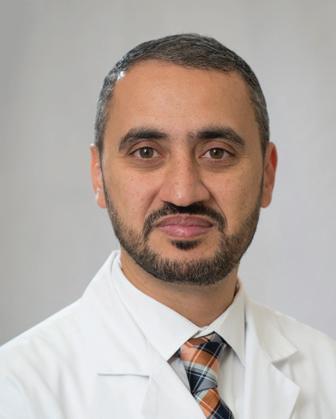
“We probably saved him between one to three days of additional hospital stay and the cost of transport by ambulance to another facility,” Dr. Tawfik says. “Having elective angioplasty available at MMC gives patients options for treatment and enables more of them to receive high-quality care in a timely manner from great doctors in their own community.”
Debora attests to the value of that care. “My former sister-in-law is a nurse, and she once told me, ‘If anything ever happens, you want to go to MMC,’” Debora says. “I was blessed to get to the right hospital. They saved my life, and I’m very, very thankful.”
Right:
ISAAC TAWFIK, MD
Monmouth Medical Center RWJBH.ORG/MONMOUTH | 23
Whoever your heart beats for, our hearts beat for you. To connect with a top cardiovascular specialist at Monmouth Medical Center, call
300 Second Avenue, Long Branch, NJ 07740










Whoever your heart beats for, our hearts beat for you.


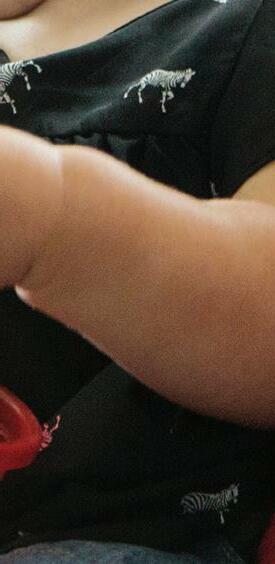




Leaders in emergency and elective angioplasty.

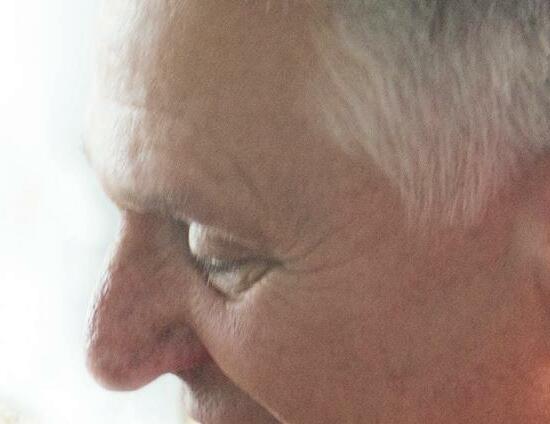
Ever feel tightness in your chest when going up a flight of stairs, or short of breath after carrying in the groceries? These can be signs of coronary artery disease. If you think you may be at risk, you should talk to a cardiac specialist at Monmouth Medical Center. At RWJBarnabas Health, we perform more elective and emergent procedures than any other health care system in New Jersey. Our heart team can clear blocked or narrowed arteries to safely restore blood flow to your heart. Schedule an appointment with one of New Jersey’s top cardiac specialists at rwjbh.org/heart




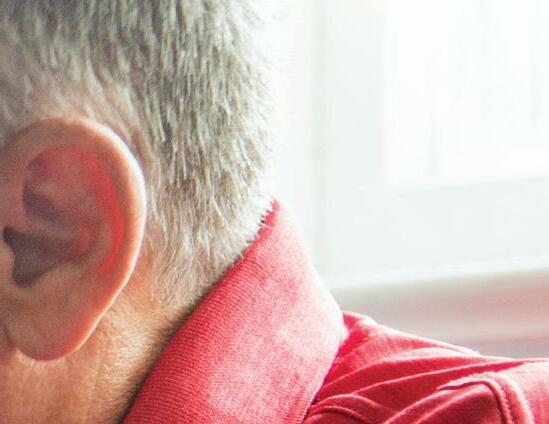
NON PROFIT U.S. POSTAGE PAID
Permit #324
Harrisburg, PA


































 ROBERT A. GRAEBE, MD
LENA L. MERJANIAN, MD
NICOLE M. MONTERO LOPEZ, MD
ROBERT A. GRAEBE, MD
LENA L. MERJANIAN, MD
NICOLE M. MONTERO LOPEZ, MD












































